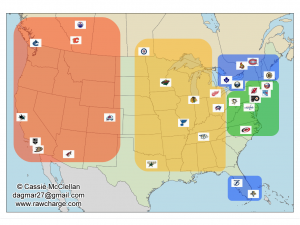On Monday afternoon the NHL’s Board of Governors agreed to implement the proposed four conference re-alignment beginning for the 2012-2013 National Hockey League season. The new format will divide the current thirty teams into four conferences featuring two consisting of eight teams and two with seven teams. The conferences have yet to be named but teams have been slotted into their respective conferences to enhance old time divisional rivalries and improve the balance of travel among all thirty NHL franchises.
The vote to approve realignment required a two-thirds majority and it was a successful vote that will now see some changes in the regular season format but also playoff action as well.

The new look of four conferences will take some getting used to but as with most changes in the new NHL fans will soon learn to love the game in the same way…we hope.
Conference A (8 teams): Anaheim Ducks, Calgary Flames, Colorado Avalanche, Los Angeles Kings, Phoenix Coyotes, San Jose Sharks, Vancouver Canucks
Conference B (8 teams): Chicago Blackhawks, Columbus Blue Jackets, Dallas Stars, Detroit Red Wings, Minnesota Wild, Nashville Predators, St. Louis Blues, Winnipeg Jets
Conference C (7 teams): Boston Bruins, Buffalo Sabres, Florida Panthers, Montreal Canadiens, Ottawa Senators, Tampa Bay Lightning, Toronto Maple Leafs
Conference D (7 teams): Carolina Hurricanes, New Jersey Devils, New York Islanders, New York Rangers, Philadelphia Flyers, Pittsburgh Penguins, Washington Capitals
The four conferences were designed to maintain current and historical rivalries but more importantly ensure that they were geographically friendly to the Western Conference teams who were growing tired of long travel through multiple time zones. The Detroit Red Wings were very vocal about their travel concerns and many people felt they would be the team to move east. However, the Dallas Stars, Minnesota Wild, and Columbus Blue Jackets had similar arguments. In the end, Detroit remains with their current Central Division teams.

The realignment allows for plenty of discussion and there are a few themes that stand out. The inclusion of two Western conferences made up of eight teams each and two Eastern conferences with one less in each has many people speculating that the NHL has allowed for the possible relocation of the struggling Phoenix Coyotes’ franchise. If the desert dogs happen to leave Glendale, Arizona as speculated (to let’s say…..Quebec City) then the NHL could simply move the “Quebec Coyotes” to Conference C joining Boston, Buffalo, Montreal, Toronto and the two sunshine teams Tampa Bay and Florida. Of course, there is no guarantee that Phoenix moves (Yeah riiiiiiight) but this scenario makes for an easy transition if the NHL welcomes back a Quebec City franchise or even a second Toronto based team. The Eastern Conferences (C and D) would then have an equal number as the Western Conferences (A and B) with fifteen teams a side – one with seven teams and the other with eight.
The NHL was careful not to upset many of the current team rivalries and honoured some of the more traditional matchups as well. The Capitals will re- join the Penguins, Flyers, Devils, Islanders and Rangers to reunite the old Lester Patrick Division that was scrapped back in 1993. The Carolina Hurricanes will make up the seventh team of that division.
The regular season format appears to be more appealing to the fans especially those wanting to see players from the opposing Conferences as each team will play outside of its conference against each team twice and within their own conference five or six times against each team. The Playoff format is simple as the top four teams in each conference qualify for post-season action (1 vs. 4, 2 vs. 3). Now with all of the technicalities out of the way, let’s take a look at the NHL Standings using the model to be implemented next season (entering Tuesday, December 6th games).
Conference A (The Gretzky Conference?):
- Vancouver (31 points)
- Phoenix Coyotes (31 points)
- Los Angeles Kings (30 points)
- San Jose Sharks (29 points)
- Edmonton Oilers (29 points)
- Colorado Avalanche (27 points)
- Calgary Flames (26 points)
- Anaheim Ducks (19 points)
Conference B (The Howe Conference?):
- Minnesota Wild (37)
- Chicago Blackhawks (36)
- Detroit Red Wings (33)
- Dallas Stars (31)
- St. Louis Blues (31)
- Nashville Predators (28)
- Winnipeg Jets (26)
- Columbus Blue Jackets (17)
Conference C (The Orr Conference?):
- Boston Bruins (35)
- Florida Panthers (34)
- Toronto Maple Leafs(32)
- Buffalo Sabres (29)
- Ottawa Senators(29)
- Montreal Canadiens (27)
- Tampa Bay Lightning (24)
Conference D (The Lemieux Conference?):
- Pittsburgh Penguins (36)
- New York Rangers (33)
- Philadelphia Flyers (33)
- Washington Capitals (27)
- New Jersey Devils (25)
- New York Islanders (23)
- Carolina Hurricanes (20)
Italics – Holding current playoff position
The impact of the new realignment will be determined next season but it appears that competition within each conference will increase as seven/eight teams fight for those four coveted playoff spots. An advantage of the four conference setup eliminates positioning the former division winners into the first, second and third ranks in the conference standings. Therefore, teams will earn their respective rankings within their conference and not be given the second playoff seed because they won the Southeast division yet finished six points back of the Atlantic’s second place team. Each and every point will become significant throughout the season as competition should remain fierce in each conference. Interdivision matchups should bring heated battles as points become even more crucial in deciding those conference playoff positions so expect a playoff type atmosphere when your team suits up to play a conference foe. Look for the four conference setup to bring some freshness back into the NHL and expect to see some of the NHL’s best stars as they come to your home rink more often.The impact of the new realignment will be determined next season but it appears that competition within each conference will increase as seven/eight teams fight for those four coveted playoff spots. An advantage of the four conference setup eliminates positioning the former division winners into the first, second and third ranks in the conference standings. Therefore, teams will earn their respective rankings within their conference and not be given the second playoff seed because they won the Southeast division yet finished six points back of the Atlantic’s second place team. Each and every point will become significant throughout the season as competition should remain fierce in each conference. Interdivision matchups should bring heated battles as points become even more crucial in deciding those conference playoff positions so expect a playoff type atmosphere when your team suits up to play a conference foe. Look for the four conference setup to bring some freshness back into the NHL and expect to see some of the NHL’s best stars as they come to your home rink more often.
Great job or should I say great info from of a real NHL fan.
Nice post Brendan.. interesting to see how it would pan out and how easy it might be for a team to get a raw deal (or good deal) under the new system..